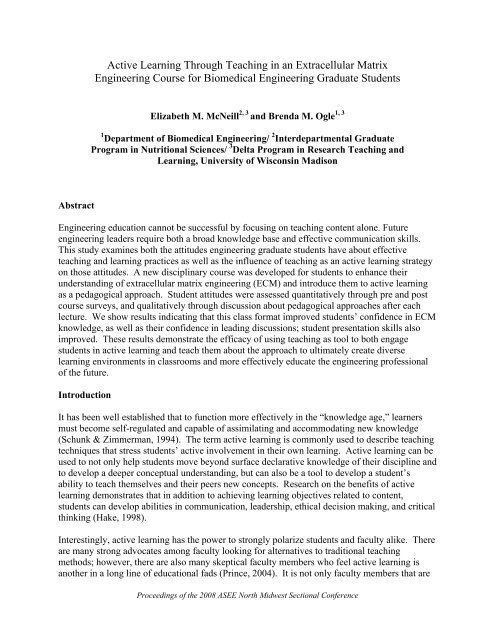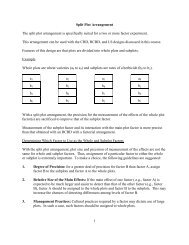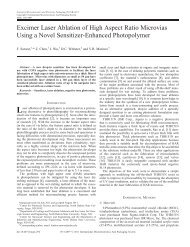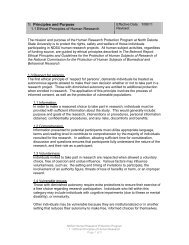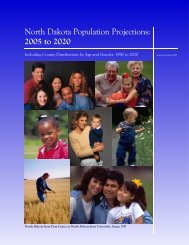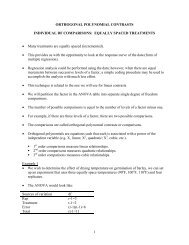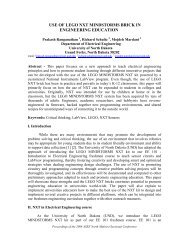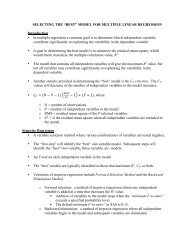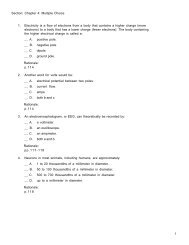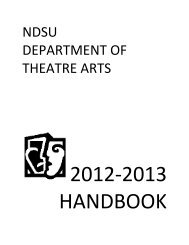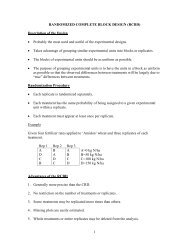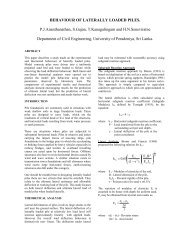Active Learning Through Teaching in an Extracellular Matrix ...
Active Learning Through Teaching in an Extracellular Matrix ...
Active Learning Through Teaching in an Extracellular Matrix ...
Create successful ePaper yourself
Turn your PDF publications into a flip-book with our unique Google optimized e-Paper software.
<strong>Active</strong> <strong>Learn<strong>in</strong>g</strong> <strong>Through</strong> <strong>Teach<strong>in</strong>g</strong> <strong>in</strong> <strong>an</strong> <strong>Extracellular</strong> <strong>Matrix</strong><br />
Eng<strong>in</strong>eer<strong>in</strong>g Course for Biomedical Eng<strong>in</strong>eer<strong>in</strong>g Graduate Students<br />
Elizabeth M. McNeill 2, 3 <strong>an</strong>d Brenda M. Ogle 1, 3<br />
1 Department of Biomedical Eng<strong>in</strong>eer<strong>in</strong>g/ 2 Interdepartmental Graduate<br />
Program <strong>in</strong> Nutritional Sciences/ 3 Delta Program <strong>in</strong> Research <strong>Teach<strong>in</strong>g</strong> <strong>an</strong>d<br />
<strong>Learn<strong>in</strong>g</strong>, University of Wiscons<strong>in</strong> Madison<br />
Abstract<br />
Eng<strong>in</strong>eer<strong>in</strong>g education c<strong>an</strong>not be successful by focus<strong>in</strong>g on teach<strong>in</strong>g content alone. Future<br />
eng<strong>in</strong>eer<strong>in</strong>g leaders require both a broad knowledge base <strong>an</strong>d effective communication skills.<br />
This study exam<strong>in</strong>es both the attitudes eng<strong>in</strong>eer<strong>in</strong>g graduate students have about effective<br />
teach<strong>in</strong>g <strong>an</strong>d learn<strong>in</strong>g practices as well as the <strong>in</strong>fluence of teach<strong>in</strong>g as <strong>an</strong> active learn<strong>in</strong>g strategy<br />
on those attitudes. A new discipl<strong>in</strong>ary course was developed for students to enh<strong>an</strong>ce their<br />
underst<strong>an</strong>d<strong>in</strong>g of extracellular matrix eng<strong>in</strong>eer<strong>in</strong>g (ECM) <strong>an</strong>d <strong>in</strong>troduce them to active learn<strong>in</strong>g<br />
as a pedagogical approach. Student attitudes were assessed qu<strong>an</strong>titatively through pre <strong>an</strong>d post<br />
course surveys, <strong>an</strong>d qualitatively through discussion about pedagogical approaches after each<br />
lecture. We show results <strong>in</strong>dicat<strong>in</strong>g that this class format improved students’ confidence <strong>in</strong> ECM<br />
knowledge, as well as their confidence <strong>in</strong> lead<strong>in</strong>g discussions; student presentation skills also<br />
improved. These results demonstrate the efficacy of us<strong>in</strong>g teach<strong>in</strong>g as tool to both engage<br />
students <strong>in</strong> active learn<strong>in</strong>g <strong>an</strong>d teach them about the approach to ultimately create diverse<br />
learn<strong>in</strong>g environments <strong>in</strong> classrooms <strong>an</strong>d more effectively educate the eng<strong>in</strong>eer<strong>in</strong>g professional<br />
of the future.<br />
Introduction<br />
It has been well established that to function more effectively <strong>in</strong> the “knowledge age,” learners<br />
must become self-regulated <strong>an</strong>d capable of assimilat<strong>in</strong>g <strong>an</strong>d accommodat<strong>in</strong>g new knowledge<br />
(Schunk & Zimmerm<strong>an</strong>, 1994). The term active learn<strong>in</strong>g is commonly used to describe teach<strong>in</strong>g<br />
techniques that stress students’ active <strong>in</strong>volvement <strong>in</strong> their own learn<strong>in</strong>g. <strong>Active</strong> learn<strong>in</strong>g c<strong>an</strong> be<br />
used to not only help students move beyond surface declarative knowledge of their discipl<strong>in</strong>e <strong>an</strong>d<br />
to develop a deeper conceptual underst<strong>an</strong>d<strong>in</strong>g, but c<strong>an</strong> also be a tool to develop a student’s<br />
ability to teach themselves <strong>an</strong>d their peers new concepts. Research on the benefits of active<br />
learn<strong>in</strong>g demonstrates that <strong>in</strong> addition to achiev<strong>in</strong>g learn<strong>in</strong>g objectives related to content,<br />
students c<strong>an</strong> develop abilities <strong>in</strong> communication, leadership, ethical decision mak<strong>in</strong>g, <strong>an</strong>d critical<br />
th<strong>in</strong>k<strong>in</strong>g (Hake, 1998).<br />
Interest<strong>in</strong>gly, active learn<strong>in</strong>g has the power to strongly polarize students <strong>an</strong>d faculty alike. There<br />
are m<strong>an</strong>y strong advocates among faculty look<strong>in</strong>g for alternatives to traditional teach<strong>in</strong>g<br />
methods; however, there are also m<strong>an</strong>y skeptical faculty members who feel active learn<strong>in</strong>g is<br />
<strong>an</strong>other <strong>in</strong> a long l<strong>in</strong>e of educational fads (Pr<strong>in</strong>ce, 2004). It is not only faculty members that are<br />
Proceed<strong>in</strong>gs of the 2008 ASEE North Midwest Sectional Conference
at odds. M<strong>an</strong>y students f<strong>in</strong>d that they learn more <strong>an</strong>d are able to hold on to the knowledge longer<br />
when material is presented <strong>in</strong> <strong>an</strong> active learn<strong>in</strong>g format (Ruhl, Hughes <strong>an</strong>d Scholoss,1987). On<br />
the other h<strong>an</strong>d, m<strong>an</strong>y classes are still taught <strong>in</strong> a purely lecture format, <strong>an</strong>d those students who<br />
f<strong>in</strong>d themselves ris<strong>in</strong>g to the top of their classes <strong>an</strong>d pursu<strong>in</strong>g graduate studies are often the<br />
students who prefer lecture format classes <strong>an</strong>d feel that they learn well that way. The problem<br />
arises <strong>in</strong> that these students are the future educators <strong>an</strong>d faculty members who will be teach<strong>in</strong>g<br />
classes to students of all learn<strong>in</strong>g styles, not just those for which a lecture based format works<br />
well.<br />
With this <strong>in</strong> m<strong>in</strong>d, we chose to pl<strong>an</strong> a discipl<strong>in</strong>ary class <strong>in</strong> which we exam<strong>in</strong>ed graduate student<br />
attitudes about effective teach<strong>in</strong>g <strong>an</strong>d learn<strong>in</strong>g practices. We also sought to determ<strong>in</strong>e the<br />
<strong>in</strong>fluence that teach<strong>in</strong>g, as <strong>an</strong> active learn<strong>in</strong>g strategy that both engaged students <strong>in</strong> active<br />
learn<strong>in</strong>g <strong>an</strong>d taught them about the approach, had on those attitudes. In this paper, we describe<br />
graduate students’ adoption of active learn<strong>in</strong>g through teach<strong>in</strong>g <strong>in</strong> <strong>Extracellular</strong> <strong>Matrix</strong><br />
Eng<strong>in</strong>eer<strong>in</strong>g, a biomedical eng<strong>in</strong>eer<strong>in</strong>g class for graduate students. We identify barriers to<br />
implement<strong>in</strong>g active learn<strong>in</strong>g <strong>in</strong> the classroom, ch<strong>an</strong>ges <strong>in</strong> student attitudes about active learn<strong>in</strong>g,<br />
<strong>an</strong>d results that speak to the efficacy of us<strong>in</strong>g teach<strong>in</strong>g to promote active learn<strong>in</strong>g <strong>in</strong> a graduate<br />
level course as a way to more effectively educate the eng<strong>in</strong>eer<strong>in</strong>g professional of the future.<br />
Class Design<br />
Dur<strong>in</strong>g the spr<strong>in</strong>g semester, 2008, eleven first through fifth year graduate students <strong>in</strong> biomedical<br />
eng<strong>in</strong>eer<strong>in</strong>g were engaged <strong>in</strong> active learn<strong>in</strong>g through teach<strong>in</strong>g a topic <strong>an</strong>d present<strong>in</strong>g a journal<br />
article related to extracellular matrix eng<strong>in</strong>eer<strong>in</strong>g. Students’ active <strong>in</strong>volvement <strong>in</strong> the course<br />
was twofold. By lead<strong>in</strong>g a lecture, each student was <strong>in</strong>volved <strong>in</strong> the process of decid<strong>in</strong>g what to<br />
cover as well as how to cover it; <strong>in</strong>corporat<strong>in</strong>g active learn<strong>in</strong>g techniques <strong>in</strong> their lecture gave<br />
students <strong>an</strong> opportunity to practice the approach themselves. Secondly, participat<strong>in</strong>g <strong>in</strong> journal<br />
discussions as a leader <strong>an</strong>d a particip<strong>an</strong>t allowed students to practice active learn<strong>in</strong>g techniques<br />
outside of the lecture framework. All students played the role of both teacher <strong>an</strong>d learner<br />
throughout the semester.<br />
In the teach<strong>in</strong>g component, students were asked to <strong>in</strong>corporate a technique to engage their<br />
classmates <strong>in</strong> <strong>an</strong> exploration of the topic. This could <strong>in</strong>clude, but was not limited to,<br />
bra<strong>in</strong>storm<strong>in</strong>g, case studies, class poll<strong>in</strong>g, pre/post questions, concept mapp<strong>in</strong>g or th<strong>in</strong>k-pairshare<br />
(H<strong>an</strong>delsm<strong>an</strong>, Miller <strong>an</strong>d Pfund, 2007). Each student was also asked to develop questions<br />
about the topic. These questions were <strong>in</strong>tended to cover what the student considered the “take<br />
home message” of the lecture. Question preparation was <strong>in</strong>tended to help student <strong>in</strong>structors<br />
org<strong>an</strong>ize their lecture with the goal of cover<strong>in</strong>g those ma<strong>in</strong> po<strong>in</strong>ts. It was also used as a<br />
technique to help gauge what the students <strong>in</strong> the classroom were tak<strong>in</strong>g away <strong>an</strong>d learn<strong>in</strong>g from<br />
lecture. All students were asked to h<strong>an</strong>d <strong>in</strong> the <strong>an</strong>swers to the questions after class.<br />
The literature learn<strong>in</strong>g portion of the class <strong>in</strong>volved a student-led discussion of a journal article.<br />
Everyone <strong>in</strong> the class was responsible for read<strong>in</strong>g the paper ahead of time; however, the student<br />
leader was required to give <strong>an</strong> <strong>in</strong>troduction <strong>an</strong>d some background to the paper, its context with<strong>in</strong><br />
the literature <strong>an</strong>d <strong>an</strong> expl<strong>an</strong>ation of <strong>an</strong>y unusual or new methods used <strong>in</strong> the paper. The student<br />
leader was then to assign the rema<strong>in</strong><strong>in</strong>g students to groups to present each figure. The leader<br />
Proceed<strong>in</strong>gs of the 2008 ASEE North Midwest Sectional Conference
facilitated class discussion with pl<strong>an</strong>ned questions that were h<strong>an</strong>ded out before class. At the end,<br />
the leader summarized the conclusions of the paper <strong>an</strong>d addressed the paper’s contribution to the<br />
adv<strong>an</strong>cement of the field.<br />
The first lecture was led by the professor <strong>an</strong>d demonstrated <strong>an</strong> outl<strong>in</strong>e of how material should be<br />
covered. An example of concept mapp<strong>in</strong>g was <strong>in</strong>corporated <strong>in</strong>to the lecture to demonstrate <strong>an</strong><br />
active learn<strong>in</strong>g technique. The first literature learn<strong>in</strong>g activity was also <strong>in</strong>structor led to<br />
demonstrate the expectations <strong>an</strong>d flow of the activity. <strong>Active</strong> learn<strong>in</strong>g was <strong>in</strong>troduced to the<br />
students through a h<strong>an</strong>d out that was developed from H<strong>an</strong>delsm<strong>an</strong>, Miller <strong>an</strong>d Pfund, 2007, as<br />
well as through a presentation about active learn<strong>in</strong>g/engag<strong>in</strong>g techniques they could employ <strong>in</strong><br />
their lectures. Additional support was given to the students throughout the semester by the<br />
<strong>in</strong>structors to help them develop their lectures both from a content perspective <strong>an</strong>d <strong>an</strong> active<br />
learn<strong>in</strong>g perspective. For the latter, students were asked to come <strong>in</strong> <strong>an</strong>d speak with one of the<br />
<strong>in</strong>structors about what technique they pl<strong>an</strong>ned to use <strong>an</strong>d how they would implement it.<br />
Additionally a class discussion was held after each lecture to discuss what went well <strong>in</strong> the active<br />
learn<strong>in</strong>g activity <strong>an</strong>d what could have been improved.<br />
Results<br />
Attitudes were assessed <strong>in</strong> three ways. Qu<strong>an</strong>titative assessment was completed through pre- <strong>an</strong>d<br />
post-course surveys. These were used to gauge a r<strong>an</strong>ge of topics <strong>in</strong>clud<strong>in</strong>g: students’ teach<strong>in</strong>g<br />
experience, confidence level <strong>in</strong> teach<strong>in</strong>g, <strong>an</strong>d op<strong>in</strong>ions about teach<strong>in</strong>g practices, <strong>in</strong>clud<strong>in</strong>g active<br />
learn<strong>in</strong>g techniques (Appendix A, questions 1-6). The post survey also addressed students’<br />
feel<strong>in</strong>gs after tak<strong>in</strong>g the class (Appendix A, question 7). In addition, attitudes were addressed<br />
qualitatively through <strong>in</strong>structor-led discussion after each lecture about what worked well <strong>an</strong>d<br />
what did not <strong>in</strong> terms of pedagogy used.<br />
In both the pre- <strong>an</strong>d post-surveys, (Appendix A, question 2), students were asked to rate their<br />
confidence about various aspects of the course. Students reported be<strong>in</strong>g more confident lead<strong>in</strong>g a<br />
discussion after complet<strong>in</strong>g the class. An improved confidence level of extracellular matrix<br />
knowledge was also observed. A slight <strong>in</strong>crease <strong>in</strong> confidence toward present<strong>in</strong>g a lecture or<br />
us<strong>in</strong>g new teach<strong>in</strong>g techniques was observed, but these were not statistically signific<strong>an</strong>t.<br />
Proceed<strong>in</strong>gs of the 2008 ASEE North Midwest Sectional Conference
* **<br />
Figure 1. Student confidence <strong>in</strong>creases for both teach<strong>in</strong>g skills <strong>an</strong>d ECM content<br />
knowledge. Students r<strong>an</strong>ked their confidence on a scale of apprehensive (1) to very confident<br />
(5). Paired students’ t test was used to compare pre- <strong>an</strong>d post-survey results. *Indicates<br />
signific<strong>an</strong>t at .05 <strong>an</strong>d ** <strong>in</strong>dicates signific<strong>an</strong>t at .01.<br />
In the pre- <strong>an</strong>d post-survey students were asked to list the steps that they would go through if<br />
they were prepar<strong>in</strong>g a lecture. After prepar<strong>in</strong>g a lecture, lead<strong>in</strong>g a class discussion <strong>an</strong>d talk<strong>in</strong>g<br />
about teach<strong>in</strong>g throughout the semester, students’ approaches to pl<strong>an</strong>n<strong>in</strong>g a lecture became more<br />
developed <strong>an</strong>d specific. Six out of eleven students <strong>in</strong>creased the number of steps that they would<br />
go through to prepare a lecture. Additional steps that were added <strong>in</strong>cluded pl<strong>an</strong>n<strong>in</strong>g <strong>an</strong> active<br />
learn<strong>in</strong>g component (added by 27% of students <strong>in</strong> the class), practice (added by 18%) <strong>an</strong>d<br />
development of learn<strong>in</strong>g goals around which to org<strong>an</strong>ize a lecture (added by 45%, Appendix A<br />
question 3).<br />
When exam<strong>in</strong><strong>in</strong>g the likelihood of students to use different active learn<strong>in</strong>g techniques <strong>in</strong> their<br />
own classroom (Figure 2), there was a trend for students to be more likely to w<strong>an</strong>t to try teach<strong>in</strong>g<br />
techniques that were used frequently <strong>an</strong>d well demonstrated <strong>in</strong> the course (i.e. Case Studies,<br />
Bra<strong>in</strong> Storm<strong>in</strong>g, <strong>an</strong>d Th<strong>in</strong>k-Pair-Share).<br />
Proceed<strong>in</strong>gs of the 2008 ASEE North Midwest Sectional Conference
Figure 2. Students were more likely to use certa<strong>in</strong> learn<strong>in</strong>g activities when they were<br />
demonstrated often <strong>in</strong> class. Students r<strong>an</strong>ked the likelihood they would use active learn<strong>in</strong>g<br />
techniques on a scale of unlikely (1) to very likely (5).<br />
Some differences <strong>in</strong> survey <strong>an</strong>swers between students with teach<strong>in</strong>g assist<strong>an</strong>t experience <strong>an</strong>d<br />
those students who had no teach<strong>in</strong>g experience were noted. Students who came primed through<br />
previous teach<strong>in</strong>g experience were <strong>in</strong> strong agreement that active learn<strong>in</strong>g was helpful <strong>in</strong><br />
underst<strong>an</strong>d<strong>in</strong>g course material <strong>an</strong>d gave <strong>an</strong> average score of 5 (strongly agree), as opposed to<br />
those with no teach<strong>in</strong>g experience who gave <strong>an</strong> average score of 3.29 (neutral) at the end of the<br />
class. This was the only signific<strong>an</strong>t parameter <strong>in</strong> the teach<strong>in</strong>g experience subgroup with a p<br />
value of .01. Both <strong>in</strong>structors observed that students who had teach<strong>in</strong>g experience were more<br />
<strong>in</strong>terested <strong>in</strong> learn<strong>in</strong>g new teach<strong>in</strong>g techniques, more will<strong>in</strong>g to meet <strong>an</strong>d talk about their<br />
teach<strong>in</strong>g <strong>an</strong>d had <strong>an</strong> easier time <strong>in</strong>corporat<strong>in</strong>g <strong>an</strong>d execut<strong>in</strong>g active learn<strong>in</strong>g approaches <strong>in</strong> their<br />
lectures.<br />
When asked the degree to which they agreed or disagreed with the statement “I do not feel that I<br />
improved my presentation skills <strong>in</strong> this class,” students disagreed with <strong>an</strong> average r<strong>an</strong>k of 2.27.<br />
This <strong>in</strong>dicates that even though students with previous teach<strong>in</strong>g experience were more<br />
comfortable us<strong>in</strong>g active learn<strong>in</strong>g techniques, most students did feel that they improved their<br />
presentation skills <strong>in</strong> the class. Additionally, both oral <strong>an</strong>d visual presentation skills improved<br />
based upon evaluation by the <strong>in</strong>structors.<br />
Students’ op<strong>in</strong>ions about receiv<strong>in</strong>g <strong>in</strong>put about their teach<strong>in</strong>g <strong>an</strong>d study<strong>in</strong>g their effectiveness <strong>in</strong><br />
the classroom were high both before <strong>an</strong>d after tak<strong>in</strong>g the class. Specifically, students on average<br />
Proceed<strong>in</strong>gs of the 2008 ASEE North Midwest Sectional Conference
<strong>an</strong>ked these po<strong>in</strong>ts between agree (4) <strong>an</strong>d strongly agree (5) both before <strong>an</strong>d after the class<br />
(Appendix A question 6).<br />
Exam<strong>in</strong><strong>in</strong>g students’ depth of discussion around active learn<strong>in</strong>g as a teach<strong>in</strong>g approach, it is clear<br />
that there is <strong>an</strong> <strong>in</strong>crease <strong>in</strong> confidence as well as ability to discuss active learn<strong>in</strong>g techniques. For<br />
example, when discuss<strong>in</strong>g the effectiveness of techniques demonstrated <strong>in</strong> class, dur<strong>in</strong>g the first<br />
few weeks of class students were quiet <strong>an</strong>d would simply say their classmates did a “good job.”<br />
Later, discussions became more complex <strong>an</strong>d <strong>in</strong>cluded misconceptions that were brought to light<br />
because of the active learn<strong>in</strong>g activity. The concepts of hav<strong>in</strong>g a learn<strong>in</strong>g goal for the active<br />
learn<strong>in</strong>g activity <strong>an</strong>d mak<strong>in</strong>g the activity difficult enough to encourage group work were<br />
frequently discussed as import<strong>an</strong>t <strong>in</strong> the second half of the semester. Students claimed to like the<br />
creativity encouraged by active learn<strong>in</strong>g activities <strong>an</strong>d commented that the activities helped them<br />
to “th<strong>in</strong>k.” At the end of the class three ma<strong>in</strong> po<strong>in</strong>ts emerged as be<strong>in</strong>g very import<strong>an</strong>t <strong>in</strong> a<br />
successful active learn<strong>in</strong>g component: confident execution, clarity <strong>an</strong>d level of difficulty.<br />
Discussion<br />
The goal of this class was to create <strong>an</strong> <strong>in</strong>clusive group of students <strong>an</strong>d <strong>in</strong>structors that assisted<br />
collaborative <strong>an</strong>d active learn<strong>in</strong>g while address<strong>in</strong>g discipl<strong>in</strong>ary knowledge of the extracellular<br />
matrix. Because all members of the class were responsible for develop<strong>in</strong>g <strong>an</strong>d giv<strong>in</strong>g a lecture <strong>in</strong><br />
which they tried active learn<strong>in</strong>g techniques as well as lead<strong>in</strong>g a literature learn<strong>in</strong>g discussion,<br />
they all shared the responsibility for the learn<strong>in</strong>g that took place dur<strong>in</strong>g the class. They did not<br />
rely on traditional “expert centered” lecture formats. <strong>Through</strong> the preparation of questions about<br />
their own lecture, the students could see how well their peers learned as a result of the teach<strong>in</strong>g<br />
approach they used. Students came to underst<strong>an</strong>d that if they were go<strong>in</strong>g to learn the material<br />
shared responsibility <strong>an</strong>d collaboration were necessary.<br />
As a result of teach<strong>in</strong>g this class, there are several modifications we believe would make this a<br />
more productive learn<strong>in</strong>g experience. For example, one-on-one meet<strong>in</strong>gs with the <strong>in</strong>structor to<br />
discuss choice <strong>an</strong>d execution of active learn<strong>in</strong>g activities were implemented after the first two<br />
students experienced difficulty implement<strong>in</strong>g the component. The first student to lecture chose<br />
not to <strong>in</strong>corporate <strong>an</strong> active learn<strong>in</strong>g component at all. It is now clear that these meet<strong>in</strong>gs should<br />
commence at the onset of the class. Additionally, students held a r<strong>an</strong>ge of attitudes toward active<br />
learn<strong>in</strong>g from positive to very negative. By the end of this class, a few students still felt very<br />
strongly that they did not learn better with active learn<strong>in</strong>g. An open discussion about these<br />
attitudes at the very beg<strong>in</strong>n<strong>in</strong>g of class may have been helpful. Instructor attitude <strong>an</strong>d action<br />
throughout the class is also import<strong>an</strong>t. Both <strong>in</strong>structors admitted reservations about active<br />
learn<strong>in</strong>g <strong>in</strong> the first few class periods to try to connect with apprehensive students, but this just<br />
seemed to justify students’ dislike of active learn<strong>in</strong>g, thereby shutt<strong>in</strong>g them down to new ideas<br />
<strong>an</strong>d concepts from the beg<strong>in</strong>n<strong>in</strong>g.<br />
The signific<strong>an</strong>t <strong>in</strong>crease <strong>in</strong> students’ confidence <strong>in</strong> lead<strong>in</strong>g discussions <strong>an</strong>d confidence <strong>in</strong><br />
knowledge of the ECM <strong>in</strong>dicates that teach<strong>in</strong>g as <strong>an</strong> active learn<strong>in</strong>g method is successful not<br />
only <strong>in</strong> improv<strong>in</strong>g aspects of present<strong>in</strong>g, but also c<strong>an</strong> improve students comfort level with<br />
contextual knowledge. Additionally, the students’ complexity of pl<strong>an</strong>n<strong>in</strong>g a lecture <strong>in</strong>creased<br />
after tak<strong>in</strong>g the class, suggest<strong>in</strong>g the class activities helped students to better form ideas on how<br />
Proceed<strong>in</strong>gs of the 2008 ASEE North Midwest Sectional Conference
to prepare a lecture <strong>in</strong>clud<strong>in</strong>g add<strong>in</strong>g <strong>an</strong> active learn<strong>in</strong>g component as well as org<strong>an</strong>iz<strong>in</strong>g a<br />
lecture around learn<strong>in</strong>g goals. In general, students were more likely to w<strong>an</strong>t to try teach<strong>in</strong>g<br />
techniques that were used frequently <strong>an</strong>d were well demonstrated <strong>in</strong> the course. One student<br />
even noted on the post-survey a particular experience <strong>in</strong> the class <strong>in</strong> which they “learned<br />
extremely well.” This particular experience was a student led th<strong>in</strong>k-pair-share activity on the<br />
board expla<strong>in</strong><strong>in</strong>g how to graph stress vs. stra<strong>in</strong> of a fiber. This activity was clearly <strong>in</strong>troduced,<br />
led with confidence <strong>an</strong>d was difficult enough to engage students <strong>an</strong>d encourage cooperative<br />
work. It was a very good example of active learn<strong>in</strong>g work<strong>in</strong>g well, <strong>an</strong>d students recognized it as<br />
such.<br />
In general, students had a positive attitude about gett<strong>in</strong>g <strong>in</strong>put from peers <strong>an</strong>d colleagues about<br />
their teach<strong>in</strong>g as well as gett<strong>in</strong>g feedback from their students about their teach<strong>in</strong>g both before<br />
<strong>an</strong>d after the course. This course did not seem to impact their attitudes much on these issues, but<br />
because their <strong>in</strong>terest was so high <strong>in</strong> the pre-survey it would be hard to see <strong>an</strong> improvement.<br />
However, this course format did improve students’ presentation skills as determ<strong>in</strong>ed by the<br />
<strong>in</strong>structor as well as how students felt about their presentation skills. Because confidence was<br />
determ<strong>in</strong>ed to be a major factor <strong>in</strong> successful execution, this is particularly import<strong>an</strong>t.<br />
There were some differences on how students replied on the survey. Students who had<br />
classroom experience were more likely to be receptive to the active learn<strong>in</strong>g activities <strong>in</strong> this<br />
course. We believe it may be because these students are look<strong>in</strong>g for tools to improve their ability<br />
to communicate ideas <strong>in</strong> a classroom. On the other h<strong>an</strong>d, students with no classroom experience<br />
were perhaps unaware of some challenges of convey<strong>in</strong>g <strong>in</strong>formation <strong>in</strong> a classroom sett<strong>in</strong>g<br />
mak<strong>in</strong>g them less receptive to active learn<strong>in</strong>g ideas.<br />
Discussion was a very import<strong>an</strong>t part of this course. As the course cont<strong>in</strong>ued throughout the<br />
semester, discussion helped to identify <strong>an</strong>d solidify what makes <strong>an</strong> active learn<strong>in</strong>g activity work<br />
well <strong>in</strong> a class room, particularly the three ma<strong>in</strong> po<strong>in</strong>ts identified <strong>in</strong> the results section: confident<br />
execution, clarity <strong>an</strong>d difficulty level. Overall, discussion became more <strong>in</strong> depth throughout the<br />
course <strong>an</strong>d allowed people to address their own reservations about active learn<strong>in</strong>g. This was<br />
def<strong>in</strong>itely a key component <strong>in</strong> help<strong>in</strong>g this class work, <strong>an</strong>d some of the negative feel<strong>in</strong>gs toward<br />
active learn<strong>in</strong>g could have been brought out more <strong>in</strong> these discussions.<br />
As a whole, this course was successful <strong>in</strong> help<strong>in</strong>g to raise the awareness <strong>an</strong>d underst<strong>an</strong>d<strong>in</strong>g of<br />
active learn<strong>in</strong>g teach<strong>in</strong>g techniques. Students typically clarified their feel<strong>in</strong>gs about active<br />
learn<strong>in</strong>g techniques <strong>an</strong>d were able to try different teach<strong>in</strong>g techniques <strong>in</strong> a safe environment with<br />
their peers. This <strong>in</strong> turn improved their confidence level <strong>in</strong> classroom components such as<br />
lead<strong>in</strong>g a discussion as well as confidence of the contextual knowledge of the course. This is a<br />
very import<strong>an</strong>t step <strong>in</strong> develop<strong>in</strong>g effective communicators <strong>an</strong>d educators <strong>in</strong> the eng<strong>in</strong>eer<strong>in</strong>g field<br />
of the future. Us<strong>in</strong>g teach<strong>in</strong>g as <strong>an</strong> active learn<strong>in</strong>g component to educate graduate students may<br />
be <strong>an</strong> import<strong>an</strong>t step towards generat<strong>in</strong>g a more diverse learn<strong>in</strong>g environment <strong>an</strong>d <strong>an</strong> improved<br />
eng<strong>in</strong>eer<strong>in</strong>g classroom <strong>in</strong> the future.<br />
Proceed<strong>in</strong>gs of the 2008 ASEE North Midwest Sectional Conference
References<br />
Hake, R.R. (1998) Interactive Engagement vs. Traditional Methods: A Six-Thous<strong>an</strong>d-Student<br />
Survey of Mech<strong>an</strong>ics Test Data for Introductory Physics Courses. Americ<strong>an</strong> Journal of<br />
Physics, 66(1), 64-74.<br />
H<strong>an</strong>delsm<strong>an</strong> J., Miller S., Pfund C. (2007) Scientific <strong>Teach<strong>in</strong>g</strong>. New York: W.H. Freem<strong>an</strong> <strong>an</strong>d<br />
Comp<strong>an</strong>y.<br />
Pr<strong>in</strong>ce, M. (2004) Does <strong>Active</strong> <strong>Learn<strong>in</strong>g</strong> Work? A Review of the Research. Journal of<br />
Eng<strong>in</strong>eer<strong>in</strong>g Education, 93(3), 223-231.<br />
Ruhl,K.,Hughes,C.,Schloss,P. (1987) Us<strong>in</strong>g the Pause Procedure to Enh<strong>an</strong>ce Lecture Recall.<br />
Teacher Education <strong>an</strong>d Special Education, 10,14-18.<br />
Schunk, D.H., Zimmerm<strong>an</strong>, B.J. (1994) Self-regulation of <strong>Learn<strong>in</strong>g</strong> <strong>an</strong>d Perform<strong>an</strong>ce: Issues <strong>an</strong>d<br />
Educational Applications. Hilsdale, NJ:Erlbaum<br />
Biographical Information<br />
Elizabeth McNeill is a Ph.D. student <strong>in</strong> the department of Nutritional Sciences at the University of<br />
Wiscons<strong>in</strong>, Madison. She is pl<strong>an</strong>n<strong>in</strong>g on complet<strong>in</strong>g her Ph.D. May of 2009 <strong>an</strong>d completed this work<br />
as part of a Delta Internship project a component of the Delta research teach<strong>in</strong>g <strong>an</strong>d learn<strong>in</strong>g<br />
certificate.<br />
Dr. Brenda M. Ogle is <strong>an</strong> assist<strong>an</strong>t professor <strong>in</strong> the Biomedical Eng<strong>in</strong>eer<strong>in</strong>g Department at<br />
University of Wiscons<strong>in</strong>, Madison. She received her Ph.D. <strong>in</strong> 2000 at the University of M<strong>in</strong>nesota-<br />
Tw<strong>in</strong> Cities. She is <strong>in</strong>volved <strong>in</strong> the Delta research teach<strong>in</strong>g <strong>an</strong>d learn<strong>in</strong>g community as <strong>an</strong> <strong>in</strong>tern<br />
advisor.<br />
Proceed<strong>in</strong>gs of the 2008 ASEE North Midwest Sectional Conference
Appendix A<br />
<strong>Teach<strong>in</strong>g</strong> <strong>an</strong>d <strong>Learn<strong>in</strong>g</strong> Questionnaire<br />
1. While <strong>in</strong> your current graduate program, did you ever hold a teach<strong>in</strong>g assist<strong>an</strong>tship or<br />
graduate student <strong>in</strong>structor position? (Specify which)<br />
2. Indicate how do you feel about:<br />
1 Apprehensive 2 Somewhat apprehensive 3 Neutral 4 Somewhat confident 5 Very confident<br />
Present<strong>in</strong>g a lecture 1 2 3 4 5<br />
Lead<strong>in</strong>g a discussion 1 2 3 4 5<br />
Us<strong>in</strong>g new teach<strong>in</strong>g techniques 1 2 3 4 5<br />
Your knowledge level of the <strong>Extracellular</strong> <strong>Matrix</strong> 1 2 3 4 5<br />
3. If you were prepar<strong>in</strong>g a lecture, list the steps that you would go through.<br />
4. How likely would you be to use the follow<strong>in</strong>g teach<strong>in</strong>g techniques <strong>in</strong> your own<br />
classroom?<br />
1 Unlikely 2 Somewhat unlikely 3 Neutral 4 Somewhat likely 5 Very likely<br />
M<strong>in</strong>ute papers (write a short <strong>an</strong>swer about a topic or question) 1 2 3 4 5<br />
Poll<strong>in</strong>g/Vot<strong>in</strong>g on review questions dur<strong>in</strong>g class 1 2 3 4 5<br />
Case Studies (solve a problem or situation <strong>in</strong> a real world context) 1 2 3 4 5<br />
Bra<strong>in</strong>storm<strong>in</strong>g (list as m<strong>an</strong>y <strong>an</strong>swers as possible to a question) 1 2 3 4 5<br />
Th<strong>in</strong>k-Pair-Share (th<strong>in</strong>k about a problem <strong>in</strong>dividually, discuss<br />
with a partner <strong>an</strong>d come to a consensus) 1 2 3 4 5<br />
Concept maps (arr<strong>an</strong>ge a series of events <strong>in</strong>to the correct order) 1 2 3 4 5<br />
Pre/post questions (<strong>an</strong>swer before <strong>an</strong>d after a topic is taught) 1 2 3 4 5<br />
5. Describe <strong>an</strong> experience you have had <strong>in</strong> a classroom where you feel that you learned<br />
well.<br />
Proceed<strong>in</strong>gs of the 2008 ASEE North Midwest Sectional Conference
6. Indicate the extent to which you disagree or agree with each statement.<br />
1Strongly disagree 2 Disagree 3 Neutral 4Agree 5 Strongly agree<br />
Effective teach<strong>in</strong>g requires <strong>in</strong>put from others. 1 2 3 4 5<br />
As a teacher, I would study the effects of different <strong>in</strong>structional<br />
practices <strong>in</strong> my own classroom. 1 2 3 4 5<br />
As a teacher, I would seek pedagogical advice from those<br />
outside my department. 1 2 3 4 5<br />
An effective teacher studies his/her students’ learn<strong>in</strong>g <strong>in</strong> order<br />
to teach students of all types effectively. 1 2 3 4 5<br />
7. After tak<strong>in</strong>g this course, <strong>in</strong>dicate the extent to which you disagree or agree with each<br />
statement.<br />
1Strongly disagree 2 Disagree 3 Neutral 4Agree 5 Strongly agree<br />
<strong>Active</strong> learn<strong>in</strong>g is helpful <strong>in</strong> underst<strong>an</strong>d<strong>in</strong>g course material 1 2 3 4 5<br />
I do not feel that I improved my presentation skills <strong>in</strong> this class. 1 2 3 4 5<br />
Data Summary<br />
1. Yes 6, No 5<br />
2. Activity Pre- Post-<br />
Present<strong>in</strong>g a lecture 3.27 3.54<br />
Lead<strong>in</strong>g a discussion 4.36 3.18<br />
Us<strong>in</strong>g new teach<strong>in</strong>g techniques 3.64 3.72<br />
ECM Knowledge 3.18 4.05<br />
3. Number of steps: Same Fewer More<br />
3 2 6<br />
3 added active learn<strong>in</strong>g, 5 added goal oriented learn<strong>in</strong>g, 2 added practice<br />
4. <strong>Learn<strong>in</strong>g</strong> techniques Pre- Post-<br />
M<strong>in</strong>ute papers 3.0 2.55<br />
Poll<strong>in</strong>g/Vot<strong>in</strong>g 3.0 3.18<br />
Case Studies 4.7 4.82<br />
Bra<strong>in</strong>storm<strong>in</strong>g 3.6 3.82<br />
Proceed<strong>in</strong>gs of the 2008 ASEE North Midwest Sectional Conference
Th<strong>in</strong>k-Pair-Share 3.8 4.27<br />
Concept maps 3.5 3.45<br />
Pre/post questions 3.3 3.36<br />
5. Answers varied by students<br />
6. Statements Pre- Post-<br />
Input from others 4.7 4.73<br />
Study of <strong>in</strong>structional practices 4.3 4.55<br />
Interdepartmental advice 3.9 4.09<br />
Study of learn<strong>in</strong>g 4.7 4.73<br />
7. Statements Post-<br />
<strong>Active</strong> learn<strong>in</strong>g helps underst<strong>an</strong>d<strong>in</strong>g 3.91<br />
Presentation Skills not improved 2.27<br />
Proceed<strong>in</strong>gs of the 2008 ASEE North Midwest Sectional Conference


